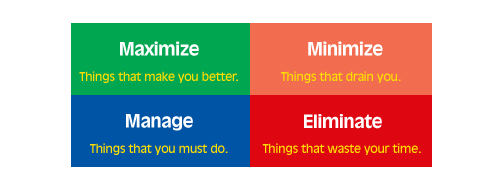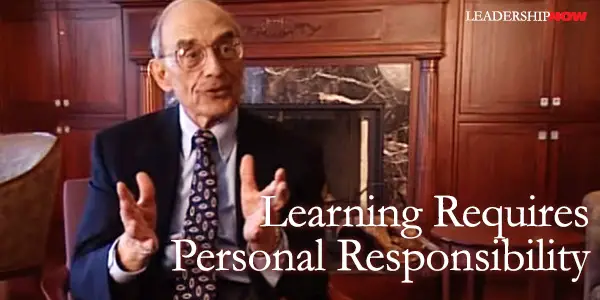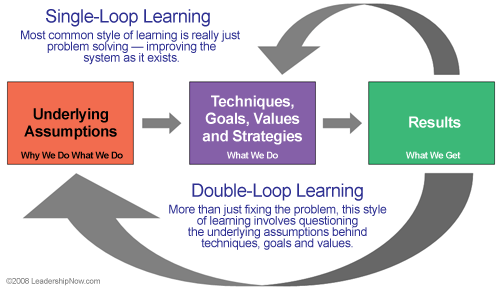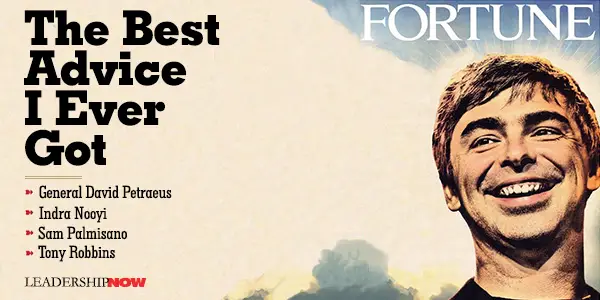 Leading Blog | Posts by Month |
 Leading Blog | Posts by Month |
05.29.08

Change the Way You See YourselfThe authors that brought you Change the Way You See Everything have taken the principles of asset-based thinking and applied them more specifically to you – the individual – in Change the Way You See Yourself. Like its predecessor, this book too is a feast for the eyes. I enjoy the graphics, but the message they convey is vital to your personal development.Asset-based thinking is a way of looking at yourself that emphasizes what is working in your life and the strengths you possess. It is a way of freeing yourself from negative and unproductive thinking. It allows you to focus on what you can do and not what you can’t do (as often seems to be our default mode of thinking). They write that with asset-based thinking, “you use surprise, serendipity, and even setbacks to make the journey more interesting and more worthwhile. You are more confident in who you are, where you are going, and how to get there.” In the section on power they invite us to look at it in a new way. Authors Kathryn Cramer and Hank Wasiak write: When it comes to power, most people think of accumulating material wealth, status, authority, knowledge, and expertise. These are potent external sources of power. AS such, they provide you with control over a vast array of resources – from money, to land, to market share, to intellectual property. While building large reservoirs of external power may be useful, it is not enough for getting results. There is another source of power equally important and often more vital to your leadership and success.  Leadership sage Warren Bennis once said, “A point of view is worth 50 IQ points.” He knew That when you live by the power of your convictions you stand taller, sit straighter, and speak more confidently. You raise the level of your game. Others know you as a “force of nature” – someone who will not be deterred and who doesn’t give up. Related Reading:
Posted by Michael McKinney at 10:40 AM
05.25.08

Tom Peters on the Definition of Leadership Tom Peters’ offers his definition of leadership in the video below. He begins by expressing a truth that is more important than the definition itself. It is not often understood by those seeking to understand the shortcomings of leadership. “Leadership in the 21st century AD is exactly what it was in the 21st century BC. Leadership is about the development, the inducement of people to grow way beyond where they believed they could go. Nothing has changed.” Leadership hasn’t changed. Leadership is influence. Peters’ definition is summed up in this quote from Robert Altman's lifetime achievement Oscar acceptance speech: "The director allows an actor to become more than they've ever dreamed of being." He says that great leaders are dealers in hope. He cites Churchill and Franklin D. Roosevelt as examples.
Posted by Michael McKinney at 06:56 PM
05.23.08

How To Troubleshoot ChangeIN Managing Complex Change, Delores Ambrose presented a matrix for creating a strategy for change and for evaluating change initiatives. It can be useful in identifying the reactions people are having to the change process and to understand why those reactions occurred. From there, one can consider what will need to be done to get a derailed change strategy back on track. The basic idea is as follows: It begins with vision – a compelling future state. It provides direction and a sense of unity in a group. Without it, people are likely to feel confused. Change requires that people move into new territory, but if they don’t feel that they have the necessary skills to effectively carry out their part, they will more than likely experience anxiety. Additionally, if there is no incentive, if people don’t see the value of the change – what’s in it for them – they are bound to be resistant to it. Incentives, while giving a rational for change, also help to build consensus. Resources are those things that people feel they will need to carry out a change initiative. They could be physical or emotional resources. Without them they are likely to feel frustrated. Finally, without a clear action plan, people will experience false starts – a sense of being on a treadmill, not really being able to get any traction.
Posted by Michael McKinney at 06:01 AM
05.21.08

Imagine Time Is a House With Four RoomsDondi Scumaci relates the following analogy on time management in her book Designed For Success:Imagine time is a house with four rooms, and all of your activities, tasks, and commitments must be placed into one of them. Each room has a name, and the name is really a goal. The first room is called Maximize. Here you will place all of the things that make you better – the actions you can take to be more prepared, informed, knowledgeable, effective, and valuable. The goal is to spend more time in this room. Into the second room you will gather the things that cause you to react. These are situations and circumstances that throw you into the frenzy of crisis mode. Call this room Minimize, because you want to reduce the amount of time you spend here. Stress also lives in this room. Incidentally, when you spend more time in the first room, you end up here less often. Next is the room for everything that steals your time. You’ll recognize the activities that belong in here because they don’t add anything. They just take. This is where gossip, perfectionism, negativity, blame storming, fear, and worry live. This room is called Eliminate. If you pay close attention, you’ll be surprised how often you go into this room and how much time you actually spend here. The last room is called Manage. It’s a place for meetings, interruptions, and communications. This is where conference calls, voice mail, e-mail, and “do you have a minute?” live. Some of these are essential and some, quite frankly are not. You must learn to tell the difference so you can out them in the rooms where they really belong. Quite often this is the most cramped room in the house, and you may find yourself climbing over things to search for what is lost in the chaos.  With your first assessment, you are likely to find some activities living in the wrong room, and you may discover the room called Maximize is nearly empty. This goal is to take inventory, put things in the proper place, and spend your time where you will realize the greatest return.
Posted by Michael McKinney at 08:46 AM
05.19.08

Golda Meir: A Study in Leadership
I KNEW a man that had met with Golda Meir in 1971. He said that she was no ordinary woman. Yet, he said, paradoxically, that was because she was such an ordinary woman. He described her as "an exceptionally intelligent, capable, balanced, and understanding mind." He said she had that rare quality of seeing things precisely as they are. Her vision was in sharp focus. Her mind was capable of piercing through the extraneous and confusing details to the central important point. She remained unconfused by the labyrinth of branches and twigs and had the trunk of the tree in clear view. Golda Meir was indeed a remarkable woman. Golda by Elinor Burkett has been released to coincide with the start of Israel's 60th Independence Day celebrations this month. This well-balanced biography is an interesting story beginning with her family fleeing Russia, where she was born in 1898, to begin again in Milwaukee, Wisconsin. There she developed a passionate commitment to Zionism, married, and pushed for their eventual relocation to Palestine in 1921. She put the cause of Zionism above all else, sacrificing even her personal life.She worked tirelessly raising money and used her gifts of charm and oratory to promote the cause. Some of her personal characteristics – self-confidence, intransigence, myopic vision, doggedness – brought her much criticism later in life, but they were exactly what was called for at that time and place in the formation of a country. She certainly had her own way of doing things. Ben-Gurion once said, “She had faith when others wavered. She believed in the absolute justice of our cause when others doubted.”  Eventually, the aftermath of the 1973 Yom Kippur War brought her time to an end, and the embattled prime minister resigned in 1974. She died on December 8, 1978, at the age of 80. She was a great leader, and this is a great study in leadership – both the good and the bad – of an ordinary woman who became an extraordinary leader. In the end, Burkett writes: A woman of greater wisdom might have resigned and let the younger generation battle it out, no matter the cost. A leader of foresight might have told her people everything they didn’t want to hear, that the situation was not sustainable, that a dozen problems were woven into the national fabric, and that they were living on quicksand. A creative prime minister might have devised new approaches to everything from ethnic divisions to peacemaking. And an innovator might have burst the national bubble of arrogant self-confidence by explaining that the political system was ossified or acknowledging that Israelis were not, in fact, the new superheroes. 
Posted by Michael McKinney at 03:49 PM
05.16.08

A Navigation System for Women in the Workplace Many of the principles presented here, of course, apply to both men and women. But she has tailored it to address the unique obstacles women face in the workplace including how to overcome the natural aversion to negotiation, how to send the right message with your wardrobe, overcoming female stereotypes and the importance of fostering a network of mentorship relationships with other female professionals. Women bring a unique set of traits to the workplace that are not as valued as they should be. Their strength lies in developing and applying them to whatever they are involved in and not trying to emulate male traits. In the book she offers Ten Commandments for Women in the Workplace. Here are some takeaways on developing your leadership capabilities:
Posted by Michael McKinney at 01:05 PM
05.15.08

Out of Context: More Isn't Better. Better Is BetterMost presentations aren’t better for being longer, most conference calls aren’t better for being extended, most meetings aren’t more productive because you spent more time in the room. It’s just that in this age of super-sizing everything from hamburgers to automobiles, we’ve become addicted to the idea that more is better. I am here to ask you to join my revolution, to tattoo on your brain, if not your backside, that “More isn’t better. Better is better.” —Frances Cole Jones,
How to Wow: Proven Strategies for Presenting Your Ideas, Persuading Your Audience, and Perfecting Your Image
Posted by Michael McKinney at 10:05 AM
05.13.08

Learning Requires Personal Responsibility THE Harvard Business Press is publishing some of the classic articles from past issues of the Harvard Business Review in handy pocket-size book form. This month they are releasing Teaching Smart People How to Learn by Chris Argyris. It first appeared in the May-June 1991 issue. In it he tells us that “success in the marketplace increasingly depends on learning, yet most people don’t know how to learn.” Worse still is the fact that those we assume to be the best at learning – knowledge workers – are not very good at it.
THE Harvard Business Press is publishing some of the classic articles from past issues of the Harvard Business Review in handy pocket-size book form. This month they are releasing Teaching Smart People How to Learn by Chris Argyris. It first appeared in the May-June 1991 issue. In it he tells us that “success in the marketplace increasingly depends on learning, yet most people don’t know how to learn.” Worse still is the fact that those we assume to be the best at learning – knowledge workers – are not very good at it.
True learning, what Argyris calls double-loop learning, requires that we be open to criticism. Most of what passes for learning is, according to Argyris, single-loop learning. Single-loop learning is, problem solving. That is to say, working on problems in the external environment – behaviors and tactics. This is really nothing more than fixing symptoms. Instead, workers need to “reflect critically on their own behavior, identify the ways they often inadvertently contribute to the organization’s problems, and then change how they act.” It is looking at “why we do what we do.” It is rethinking the assumptions behind why we do what we do.  Argyris describes single and double-loop learning using this analogy: a thermostat that automatically turns on the heat whenever the temperature in a room drops below 68 degrees is a good example of single-loop learning. A thermostat that could ask, ‘‘Why am I set at 68 degrees?’’ and then explore whether or not some other temperature might more economically achieve the goal of heating the room would be engaging in double-loop learning. The ideas Argyris lays out in this article are truer today than when he wrote it. Knowledge workers must by the nature of their work, put themselves – their identity - out there in the workplace. This makes them more vulnerable and more likely to become defensive when they are shown to be responsible, to some degree, with a problem. Double-loop learning requires taking personal responsibility and a willingness to challenge what one is doing. Know Thyself begins to take on a new dimension. 
Posted by Michael McKinney at 09:23 PM
05.09.08

Is Your Problem Self-Correcting?From the Pick Your Battles Department comes some well-phrased, good advice from Bryan Hurlbut from his book Making It Count. I’ve adapted a few excerpts to give you the main idea:With so many battles raging around us, it’s important to realize our limitations. We deal with other’s emotions and our emotions; we deal with coworkers’ inadequacies and our own inadequacies; we deal with abused authority and our own frustrations with abused authority. There are so many opportunities to become frustrated, disheartened, exasperated, angry and dejected that we really don’t need to go looking for things to add to our emotional and professional plates.Keep in mind too, that from time to time you will be the one with the “brilliant” solution that proves to be defective or your assessment of someone else’s solution is wrong and it may just be the thing that works. So don’t sabotage the situation. He cautions, “Don’t walk through the situation constantly trying to prove that you are right and others are wrong. When the decision is made, try with all your might to make it work, and if it fails, you will have no regrets. Equally as important, you have proven yourself to be a team player who is not a spoiled child and who can continue to bring great value to an organization even when you don’t get your way.” Well put. Most problems do correct themselves. If the damaged caused by the solution isn’t irreparable, give it time and move on. He has written up a lot of good advice in this little book that will help you leave a situation better than you found it and here is one more to keep in mind: You are not responsible for what you say; you’re responsible for what people hear. Good material. Related Posts:
Posted by Michael McKinney at 10:52 AM
05.07.08

Out of Context: Great Followership Is Harder Than Leadership"It’s no surprise that books on leadership, promising to revel the secrets of countless football coaches and historical figures as disparate as Moses and Attila the Hun, outnumber those on followership several thousand to one. After all, leadership is the prize that ambitious men and women have struggled and even died for at least since Alexander the Great. Whether the field is politics, business, science, or the arts, leaders are at the center of the action, the envied if not enviable stars whose lives seem to burn a little brighter than our own. We aspire to their power and its perquisites even as we take unseemly pleasure when one of them stumbles and falls. Indeed, the moment when each of us realizes he or she is mostly a follower, not a leader, is a genuine developmental milestone; who forgets that painful leap over the line of demarcation between the boundless fantasies of childhood and the sober reality of an adulthood in which we will never quite become the god we hoped to be?" —Warren Bennis, The Art of Followership
Posted by Michael McKinney at 06:50 AM
05.06.08

Fortune: The Best Advice I Ever Got
Fortune magazine asked 19 people for the best advice that most influenced their lives. Here are several excerpts from that feature: General David Petraeus: Commanding general, multinational force – Iraq
Indra Nooyi: Chairman and CEO, Pepsico
Sam Palmisano: Chairman and CEO, IBM
Tony Robbins: Performance coach
What’s the best advice you ever got?
Posted by Michael McKinney at 12:23 AM
05.05.08

Learning Leadership the Hard WayInnovator and leader, Dov Frohman asserts that leadership must be learned the hard way—by doing it. In Leadership the Hard Way, Frohman likens the situation confronting today’s leaders to a pilot flying through a thunderstorm.“It is precisely these forces of increased turbulence that have fueled the growing preoccupation with leadership. In such an environment, leadership isn’t a luxury. It’s a matter of survival! Yet the very forces that make leadership more critical also make teaching it virtually impossible. What it takes to lead an organization through that turbulence isn’t simple or straightforward. There is just too much uncertainty. And it takes personal courage. You don’t really know what you will do at the moment of truth. No matter how much training you have (or how many leadership books you have read), nothing quite prepares you for that moment when you enter the eye of the storm!”He believes this means embracing turbulence and crisis, not avoiding it. It means “flying through the thunderstorm.” While there are basic principles to leadership, Frohman says “there are no simple recipes. Until you have lived it, you don’t really know how to do it.” If you are going to learn to lead, you must develop a “particular frame of mind, a distinctive way of perceiving and acting. You must free yourself from habitual ways of looking at things, cultivate an independent and questioning perspective, and be ready to embrace alternative and counterintuitive points of view.” Frohman offers four resources that aspiring leaders can use to learn how to lead: 1. Stay True to Your Passion. No leader can be effective who does not identify 100 percent with the organization’s mission. Because this identification between leader and organization is so important, it’s critical for you as an aspiring leader to identify your passion – what really drives you – and to stay true to that passion through the course of your career. If you do, you will find that this passion is a powerful resource for guiding you through the challenges of leadership the hard way. 2. Get An Invisible Mentor. No aspiring leader has to wait to be assigned a mentor. Choose and invisible mentor, someone whose behavior you study from afar. Choose someone whose leadership style you relate to and admire. Study that person closely. 3. Become a Reflective Practitioner. A term coined by organizational theorist Donald Schön in his 1983 book, a reflective practitioner is one who systematically reflects on one’s own experiences. It’s the kind of learning that happens in the moment. Build systematic reflection into your everyday activity. 4. Learn From Your People. A close relationship with your people can give you a tremendous resource for bootstrapping your leadership capabilities. There are a variety of ways to develop that close bond – be present in the organization, don’t be afraid to expose one’s own mistakes to the organization, welcome dissent, and use your own behavior strategically. Aspiring leaders should get in the habit of thinking of their actions as a form of communication.
Posted by Michael McKinney at 04:01 PM
05.02.08

Leadership Books: May 2008Here's a look at some of the best leadership books to be released in May.




Posted by Michael McKinney at 10:58 AM
|
BUILD YOUR KNOWLEDGE


How to Do Your Start-Up Right STRAIGHT TALK FOR START-UPS 
Grow Your Leadership Skills NEW AND UPCOMING LEADERSHIP BOOKS 
Leadership Minute BITE-SIZE CONCEPTS YOU CAN CHEW ON 
Classic Leadership Books BOOKS TO READ BEFORE YOU LEAD |
|